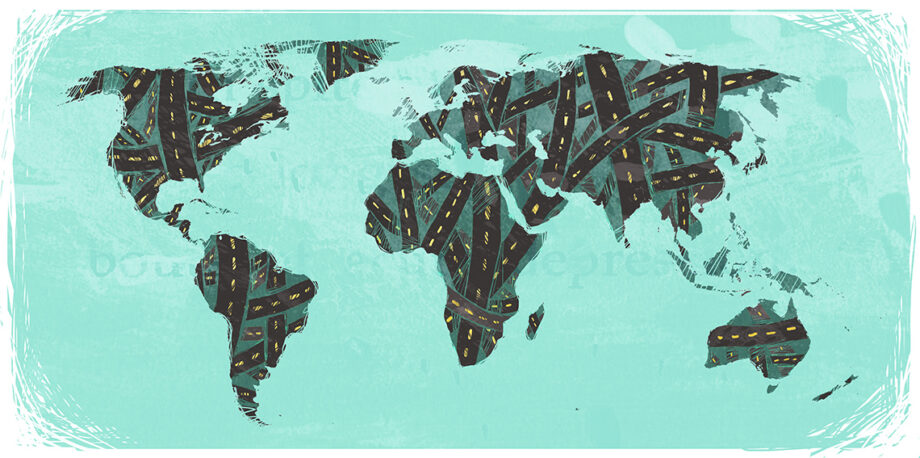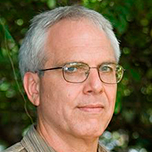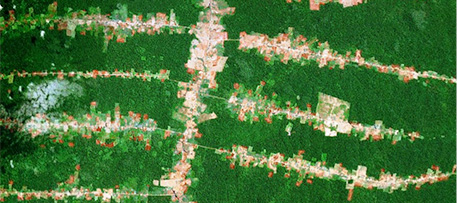September 2, 2014 — 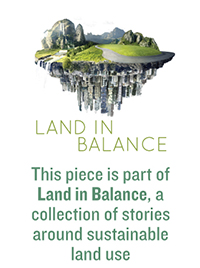 “The best thing you could do for the Amazon is to blow up all the roads.” These might sound like the words of an eco-terrorist, but it’s actually a direct quote from Eneas Salati, a forest climatologist and one of Brazil’s most respected scientists.
“The best thing you could do for the Amazon is to blow up all the roads.” These might sound like the words of an eco-terrorist, but it’s actually a direct quote from Eneas Salati, a forest climatologist and one of Brazil’s most respected scientists.
Many scientists share Salati’s anxieties because we’re living in the most explosive era of road expansion in human history. The International Energy Agency predicts that by 2050 we will have 60 percent more roads than we did in 2010. That’s about 25 million kilometers of new paved roads — enough to circle the Earth more than 600 times.
In new research published last week in Nature, we’ve developed a global “roadmap” of where to put those roads to avoid damaging the environment. Our maps are also available to the public on a new website.
Around nine-tenths of new roads will be built in developing nations, which sustain the most biologically important ecosystems on Earth.Roads today are proliferating virtually everywhere — for exploiting timber, minerals, oil and natural gas; for promoting regional trade and development; and for building burgeoning networks of energy infrastructure such as hydroelectric dams, power lines and gas lines.
Even national security and paranoia play a role. The first major roads built in the Brazilian Amazon were motivated by fears that Colombia or the U.S. might try to annex the Amazon and steal its valuable natural resources. India’s current spate of road building along its northern frontier is all about defending its disputed territories from an increasingly strident China.
According to the IEA, around nine-tenths of new roads will be built in developing nations, which sustain the most biologically important ecosystems on Earth, such as tropical and subtropical rainforests and wildlife-rich savanna-woodlands.
Crucially, such environments also store billions of tonnes of carbon, harbor hundreds of indigenous cultures, and have a major stabilizing influence on the global climate.
Killer Roads
Why are roads regarded as disasters for nature?
Far too often, when a new road cuts into a forest or wilderness, illegal poachers, miners, loggers or land speculators quickly invade — unleashing a Pandora’s box of environmental problems.
For instance, my colleagues and I recently found that 95 percent of all forest destruction in the Brazilian Amazon has occurred within 5 kilometers of roads (notably, we also found that many Amazonian roads are illegal; for every kilometer of legal road, there were three kilometers of illegal roads). Other research has shown that major forest fires spike sharply within a few dozen kilometers of Amazon roads.
The Congo Basin is reeling from a spree of forest-road building by industrial loggers, with over 50,000 kilometers of new roads bulldozed into the rainforest in recent years. This has opened up the forest to a tsunami of hunting. The toll on wildlife has been appalling; in the last decade, for instance, around two-thirds of all forest elephants have been slaughtered for their valuable ivory tusks.
In Peru, a new highway slicing across the western Amazon has led to a massive influx of illegal gold miners into formerly pristine rainforests, turning them into virtual moonscapes and polluting entire river systems with the toxic mercury they use to separate the gold from river sediments.
Avoid the First Cut
Many road researchers believe the only safe way to protect a wilderness is by “avoiding the first cut” — keeping it road free. This is because an initial road opens up a forest to deforestation, which then spreads contagiously, like a series of tumors.
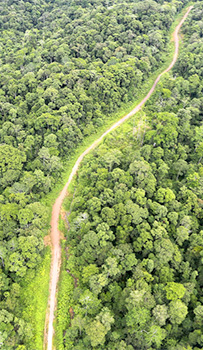
Avoiding the first cut is critical – a forest road in Sabah, Malaysia (Rhett Butler)
And that cancer quickly grows. An initial road slicing into a wilderness typically spawns a network of secondary and tertiary roads, allowing deforestation to easily metastasize.
For instance, the first major highway in the Amazon — completed in the early 1970s to link the cities of Belem and Brasilia — was initially just a razor-thin cut through the forest. Today, that narrow incision has grown into a 400-kilometer-wide slash of forest destruction across the entire eastern Amazon.
But We Need Roads
And yet, for all the environmental perils of roads, they are also an indispensable part of modern societies. Most economists love roads — seeing them as a cost-effective way to promote economic growth, encourage regional trade and provide access to natural resources and land suitable for agriculture.
How do we balance these two competing realities — between road lovers aspiring for wealth and social development, and road fearers hoping to avoid ecological Armageddon?
This vexing question has been the focus of a talented group of researchers I’ve been leading over the past two years, from Harvard, Cambridge, Melbourne, Minnesota, Sheffield and James Cook Universities, and the Conservation Strategy Fund.
A Global Roadmap
Our scheme has two components. The first is a map that attempts to illustrate the natural values of all ecosystems worldwide. We built this map by combining data on biodiversity, endangered species, rare habitats, critical wilderness areas and vital ecosystem services across the Earth.
We added in parks and other protected areas, as these are also high priorities for nature conservation.
The second component is a road-benefits map. It shows where roads could have the greatest benefits for humankind, especially for increasing food production.
Focusing on food is vital because, with continuing rapid population growth and changing human diets, global food demand is expected to double by 2050.
Roads affect food because large expanses of the planet — especially in sub-Saharan Africa and expanses of Asia and Latin America — are populated by small-scale farmers who produce much less food than they could if they had new or better roads. Such roads could give them ready access to fertilizers, modern farming methods and urban markets to sell their crops.
In these regions most of the native vegetation has already been cleared, so intensifying farming shouldn’t have major environmental costs. In these contexts, new or better roads (along with other investments in modern farming methods) are a key way to help struggling farmers to boost their productivity.
A potential bonus of this strategy is that, as farming becomes more productive and rural livelihoods more prosperous, regions with better roads tend to act as “magnets” — attracting people from elsewhere, such as the margins of vulnerable forests.
In this way, investing in better roads in appropriate areas can help to focus and intensify farming, accelerating food production while hopefully helping to spare other lands for nature conservation.
Conflict Zones, but Reasons to Hope
By intersecting our environmental-values and road-benefits maps, we have estimated the relative risks and rewards of road building for Earth’s entire land surface — some 13.3 billion hectares in total.
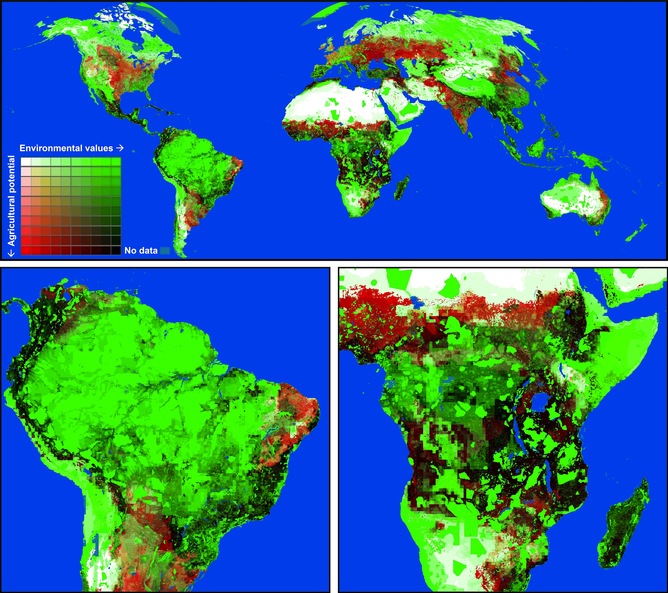
A new “global road map” shows where roads can have the most benefit with the least environmental harm. Courtesy of William Laurance.
In our map, green-toned areas are priorities for conservation where roads should be avoided if possible, and red-toned areas are priorities for agriculture.
Dark-toned areas are “conflict zones” — where environmental and agricultural priorities are likely to clash (light-color red areas are lower priorities for both environment and farming).
The good news is that there are substantial areas of the planet where agriculture can be improved with modest environmental costs.
But there are also massive conflict zones — in sub-Saharan Africa, expanses of Central and South America, and much of the Asia-Pacific region, among others. These hotbeds of conflict often occur where human population growth is rapid and there are many locally endemic species — those with small geographic ranges that are especially vulnerable to intensive development.
Our global road map is, admittedly, an exceedingly ambitious effort. Yet our hope is that our strategy can be incorporated with finer-scale local information to help inform and improve planning decisions at national and regional scales.
Our effort is a first step toward a vital goal: a global plan for road expansion. We’re not so naïve as to believe everyone will immediately adopt it, but such efforts are unquestionably a crucial priority.
There is precious little time to lose if we don’t want to see the world’s last wild places overwhelmed by an onslaught of roads, destructive development and the roar of fast-moving vehicles. ![]()
Editor’s note: The views expressed here are those of the author and not necessarily of Ensia. We present them to further discussion around important topics. We encourage you to respond with a comment below, following our commenting guidelines, which can be found here. In addition, you might consider submitting a Voices piece of your own. See Ensia’s “Contact” page for submission guidelines.
This article was originally published on The Conversation. Read the original article.
Disclosure statement: Bill Laurance receives funding from the Australian Research Council and other scientific and philanthropic organizations. In addition to his appointment as distinguished research professor and Australian Laureate at James Cook University, he also holds the Prince Bernhard Chair in International Nature Conservation at Utrecht University, Netherlands. This chair is co-sponsored by Utrecht University and WWF-Netherlands.
Ensia shares solutions-focused stories free of charge through our online magazine and partner media. That means audiences around the world have ready access to stories that can — and do — help them shape a better future. If you value our work, please show your support today.
Yes, I'll support Ensia!